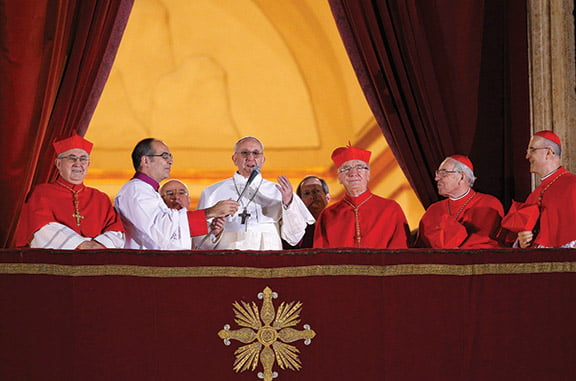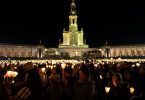
When Pope Francis greeted the crowd in St. Peter’s Square the night of his election, he broke several traditions in the process. He refused to stand on a platform elevating him above the cardinals, kept his own cross instead of accepting a more ornate one, and asked the people to bless him before he blessed them. CNS photo by Paul Haring.
By Anita McSorley
anita.mcsorley@theleaven.org
There’s an old joke with which I love to rib my friend Michael Podrebarac that goes something like this.
Question: What’s the difference between a liturgist and a terrorist?
Answer: You can always negotiate with a terrorist.
But I have to admit that Michael, archdiocesan liturgist, came in mighty handy these past few days of papal election and installation.
That’s because it seems like a lot that’s happened has been in a kind of “code” or a language of papal traditions and rituals that only certain people speak.
Sure, we’ve all figured out by now that this guy is going to drive his security detail and his press secretary crazy — he won’t stay on script and he won’t stay where you put him. He’s just as likely to wave off the papal limo as he is to ride in it.
But another change that seems to be taking place is his adaptation of certain elements of papal ritual and tradition. And for a better understanding of these, we’ve invited our very own terrorist, oops, liturgist to explain it all to us.
Anita: Welcome, Michael, and thank you so much for being willing to help us out here.
Michael: Glad to offer my assistance, especially with my background in “hostage negotiation” when it comes to liturgy!
Anita: Let’s start at the beginning, Michael. I understand that Pope Francis from the get-go started breaking with tradition. Cardinal Timothy Dolan of New York reported that after returning, vested as pope, from the Room of Tears, he declined to sit in the white chair on the platform prepared for him. Instead, he greeted the cardinals standing and “on our own level,” said Cardinal Dolan. How is that a break in tradition and what might it mean?
Michael: Well, first let me say, Anita, that I can’t know what was actually in the new pope’s mind when he did all these things. All I can do is explain what message his various actions might have signaled to the cardinals and, then later, to various other groups, based on the language of liturgy and ritual, based on what message it signaled to me.
Anita: OK, I get that. But back to the chair on the platform.
Michael: The whole business of greeting the cardinals on the floor rather than from a chair simply indicates his willingness to embrace the cardinals as brothers. Pope John XXIII did a similar thing, when, as the first cardinal came to him to kiss his feet, which was customary at the time, he immediately announced that the custom was banned henceforth. Neither Pope John nor Pope Francis were unaware of their singular office as they dispensed with these customs; it’s just that each wished in his own way to indicate that they approached their new office with a certain sense of collegiality.
Anita: How did the name Francis hit you when you first heard it? What kind of message did it send?
Michael: I wept. Of course, I was spiritually raised by the Franciscans in Emporia where I grew up, and so have always loved the Franciscan spirituality, being a third order Franciscan myself. I wept also because I love St. Francis, and his name immediately suggested the kind of pope we had just received, since I did not know him or his background other than what I had read in The Leaven. And I knew that no one would be foolish enough to choose such an unprecedented and meaningful name if he was not serious about its implications.
Anita: Was there any symbolism in what he did and did not do when he walked out on the balcony — like substituting the traditional Latin greeting with an Italian one?
Michael: Pope Francis came out in his simple white cassock. He chose not to wear the traditional cape and stole, although he did put on the stole to bless the people when it was time. It again made me think of St. Francis, who stripped naked before the people of Assisi in order to indicate that he belonged only to God — not to convention nor to human custom. Of course, there is nothing wrong with either conventions or customs, in themselves.
He spoke to the people in their language. This is not bad. I love Latin, and, as people will tell you, I love tradition and ceremony! But Pope Francis decided to greet everyone like they were his friends, because this is how he sees us — as his friends, whom he has been called to serve.
Much has been made about his asking the people’s blessing, including those who feel the need to insist that he simply asked them to ask for God’s blessing for him. Why can’t people bless their pope? We bless the Lord, don’t we?
All a blessing really means is to admit God’s power and glory. The pope needs our blessings and prayers! Pope Francis knows this as he inherits a church that is in a period of intense struggle within and without. And, of course, he then blessed us in the traditional manner and words. Nothing substantial was lost by the way he began his public ministry, but much was gained, I believe.
Anita: A first order of business, it seems, was to reach out to the chief rabbi of Rome. What should we make of that?
Michael: Pope Francis understands what Pope Pius XII once said: “We [Christians] are all Semites (people of the seed of Abraham).” We belong, in a sense, to the Jewish people, our “elder brethren” in our faith in the Lord God. Pope John XXIII and Pope Paul VI, and of course Pope John Paul II, did much to strengthen our relationship with the Jewish people. Pope Benedict inherited and maintained such relations with the Jewish people, and Pope Francis, who in Buenos Aires even celebrated an interfaith Hanukkah with the Jews of Argentina, is not going to let this essential relationship between Catholics and Jews go by the wayside.
Anita: What was the same and what was different about the pope’s inaugural Mass? And more importantly, what does it all mean?
Michael: That’s an excellent question, and it raises an important point. Nothing in substance was different. The inaugural Mass followed nearly the same order as last time, and the time before, and the time before that. Remember, it was Pope John Paul I who dispensed with the traditional coronation of the pope. Now that’s changing tradition!
Pope Francis seems to prefer the altar candles arranged the way they were during Pope John Paul II’s pontificate. No problem. Perhaps he prefers a simpler style of vesture than some of the vestments available to him. They still are proper vestments for Mass. Perhaps he likes to preach from the cuff as well as from a script. Then we can better know his heart and what he is thinking!
Style is one matter, and substance another.
Anita: Let’s wind up, Michael, on a little note about the sartorial splendor of the papacy. More specifically, what happened to the red leather shoes? I know that as Cardinal Bergoglio this guy literally wore out the leather on his shoes on the streets of Buenos Aires. Doesn’t he have to trade those old black shoes in on some snazzy red ones?
Michael: Ah, the shoes! Pope John Paul II preferred brown shoes (when he wasn’t wearing hiking boots or skis!). Pope Benedict restored the traditional red ones, and that was nice. We are told that Pope Francis has typically owned one pair of shoes at a time, and that, before he left for the conclave, his staff in Buenos Aires noticed that his shoes were getting old and worn. So they went together to buy him a new pair.
Most likely he wears them because he has them, and once he has worn them out (sooner, rather than later if he doesn’t start taking the papal car!), then we will see what kind of shoes he wears next.
Remember, Jesus told his disciples to take only one pair of shoes with them when they went out to minister. Pope Francis seems to have given this instruction extraordinary attention.
And that’s OK.






